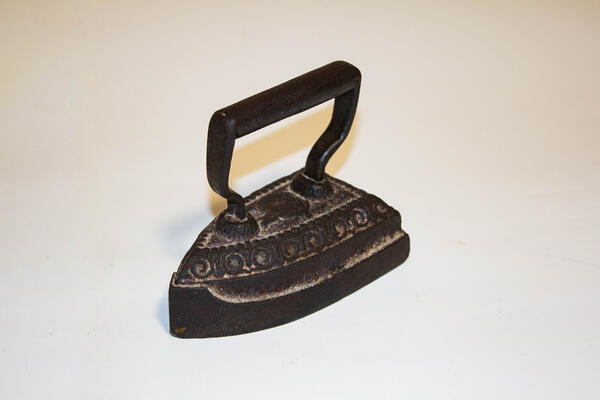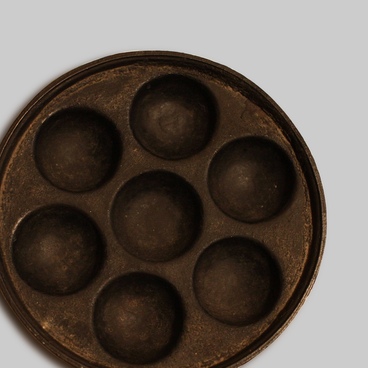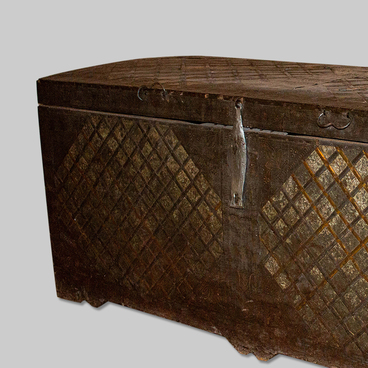The ancient Greeks began to use iron to press their clothes as early as the 4th century BC. They came up with a way to pleat their tunics with a hot metal rod that looked like a rolling pin. The Romans, on the other hand, knocked wrinkles out of their clothes using another device: a metal hammer.
Cast clothing irons were first made as late as the 18th century. The industrial production of irons was quite common in the Urals with its rich iron deposits. First, the craftsman cast the ‘body’ of the iron into a special mold, then the handle was soldered on separately. Depending on the weight of the iron, it could be given a respective mark. Large cast clothes irons weighed up to ten kilos and were intended for ironing coarse fabrics. The smallest iron weighed about one kilo and was designated ‘No. 1.’ One of such miniature cast irons is on display at the Fyodor Reshetnikov Museum.
In order to heat the iron, it was placed in the stove or directly on the open fire. Since the handle got heated along with the iron, the latter could be made removable. The heating process took about half an hour. Such an iron cooled down rather quickly, so one did not have much time to iron the clothes. In order not to wait for it to reheat, people often had two irons or two iron soles. However, not everyone could afford them. Many had to make do with a wooden smoother and a special rolling pin.
The iron was not only a household item, it had artistic value as well. The body of the iron was often decorated with cast ornament with plant or animal designs. Expensive irons, bought by the wealthy, were often adorned with inserts and plates of other metals, often even gold and silver.
Cast irons were an integral part of family life and passed from parents to children by inheritance. In Russia and Ukraine, people sometimes placed their irons next to the samovar on a lace tablecloth, showing them off like a beautiful vase or painting. Such an iron suggested wealth in the family. In the USSR, cast clothing irons were produced until the 1960s. While electric irons had been around for quite a while, there were no electric outlets in many homes. Today, the design of a cast clothing iron is often used to create cast iron boxes.
Cast clothing irons were first made as late as the 18th century. The industrial production of irons was quite common in the Urals with its rich iron deposits. First, the craftsman cast the ‘body’ of the iron into a special mold, then the handle was soldered on separately. Depending on the weight of the iron, it could be given a respective mark. Large cast clothes irons weighed up to ten kilos and were intended for ironing coarse fabrics. The smallest iron weighed about one kilo and was designated ‘No. 1.’ One of such miniature cast irons is on display at the Fyodor Reshetnikov Museum.
In order to heat the iron, it was placed in the stove or directly on the open fire. Since the handle got heated along with the iron, the latter could be made removable. The heating process took about half an hour. Such an iron cooled down rather quickly, so one did not have much time to iron the clothes. In order not to wait for it to reheat, people often had two irons or two iron soles. However, not everyone could afford them. Many had to make do with a wooden smoother and a special rolling pin.
The iron was not only a household item, it had artistic value as well. The body of the iron was often decorated with cast ornament with plant or animal designs. Expensive irons, bought by the wealthy, were often adorned with inserts and plates of other metals, often even gold and silver.
Cast irons were an integral part of family life and passed from parents to children by inheritance. In Russia and Ukraine, people sometimes placed their irons next to the samovar on a lace tablecloth, showing them off like a beautiful vase or painting. Such an iron suggested wealth in the family. In the USSR, cast clothing irons were produced until the 1960s. While electric irons had been around for quite a while, there were no electric outlets in many homes. Today, the design of a cast clothing iron is often used to create cast iron boxes.



